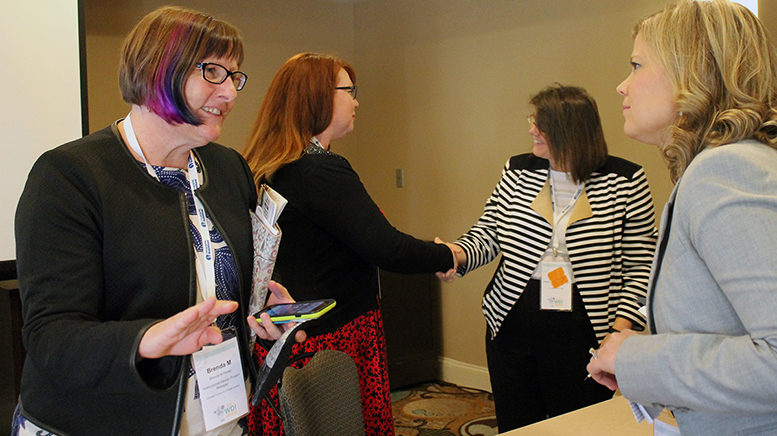NEWPORT BEACH, Calif. — Community college leaders who have worked on federal Trade Adjustment Assistance Community College and Career Training (TAACCCT) grants are hoping to keep the momentum going as federal funding winds down.
Sustaining these programs requires strong support from the college president, faculty buy in and “a champion, an advocate in the trenches, deeply committed to the program,“ said Christina Amato, manager of TAACCCT grant-funded projects at Sinclair Community College in Ohio, who was among TAACCCT grantees speaking at American Association of Community Colleges’ Workforce Development Institute. The program has awarded $1.9 billion over the past four years to create partnerships with the goal of retraining displaced, older adults.
Sinclair was the lead on a project that called for the adoption of competency-based education, which faced opposition in the beginning. People came around eventually, when course completion rates increased and students finished the program faster, Amato said.
“We learned we needed to radically restructure advisory boards. When we brought them in, they said they didn’t care if a program was credit or non-credit. They just wanted trained people,” Amato said. She also learned talking to human resources people wasn’t enough; CEOs and CFOs had a better handle on job forecasting.
Another challenge was being responsive when training people for rapidly evolving industries like information technology. “Employers were telling us what we’re teaching isn’t advanced enough. We had to revise our curriculum,” she said.
“The biggest lesson learned – and the hardest work we ever did – was figuring out how to work leaner and harder and bring more to the table when TAACCCT resources dry up, “ Amato said.
Communication is critical
“We learned sustainability is about communications channels we developed through TAACCCT grants,” said Brenda Perea, instructional design project manager for the Colorado Community College System.
As part of Colorado’s first TAACCCT grant, the system sent mobile learning labs to train employees all over the state. At first, the mobile labs, which focused on water quality management and advanced manufacturing, had few takers, Perea said.
When education leaders talked about education and return on investment to those companies, they agreed to talk to legislators. As a result, two more learning labs were funded, and the one on water quality was adopted by the state and provided critical help when a mine burst, polluting a river.
“That happened because we were listening,” Perea said.
Reform of developmental education was not a major focus of Colorado’s TAACCCT grant, Perea said, but that became critical in the program’s success. Because some students had to take five remedial courses before they could take a college-level course, “we were losing students before they could qualify for TAACCCT courses,” Perea said.
The Colorado system created a pilot program pairing developmental English and math courses with college-level courses. That led to increased completion rates and eventually to a statewide mandate calling for all colleges to redesign developmental education.
“When you’re starting a project, the most important thing is that everyone hears the same message,” Perea said. Her office developed a media kit to ensure all the TAACCCT partners present a consistent message to legislators and businesses.
Industry changes
The TAACCCT grant-funded project at Casper College in Wyoming, which was aimed at training people for jobs in the energy sector, faced some challenges when the bottom fell out of the state’s energy industry. When the college applied for the grant, job growth was exploding, but now the state is losing jobs.
Businesses are still working with the college even though they can no longer offer employment, said Rachel Chadderdon, TAACCCT project manager at Casper. Instead of creating new curriculums, the college is working on embedding soft skills into the existing program.
The program is also facing challenges due to a change in leadership at the college and budget cuts. As a result, some critical positions, including the head of Casper’s simulator center, won’t be replaced, and two programs with low-enrollment – extracting and process technology – will be dropped.
The focus has shifted to continuous improvement, Chadderdon said. “We decided to clarify what we do, make it more accessible and promote what we have.”
As TAACCCT moves toward the endpoint, grantees might want to think about transitioning their programs into the National Science Foundation’s Advanced Technological Education (ATE) program, suggested Celeste Carter, ATE program manager.

